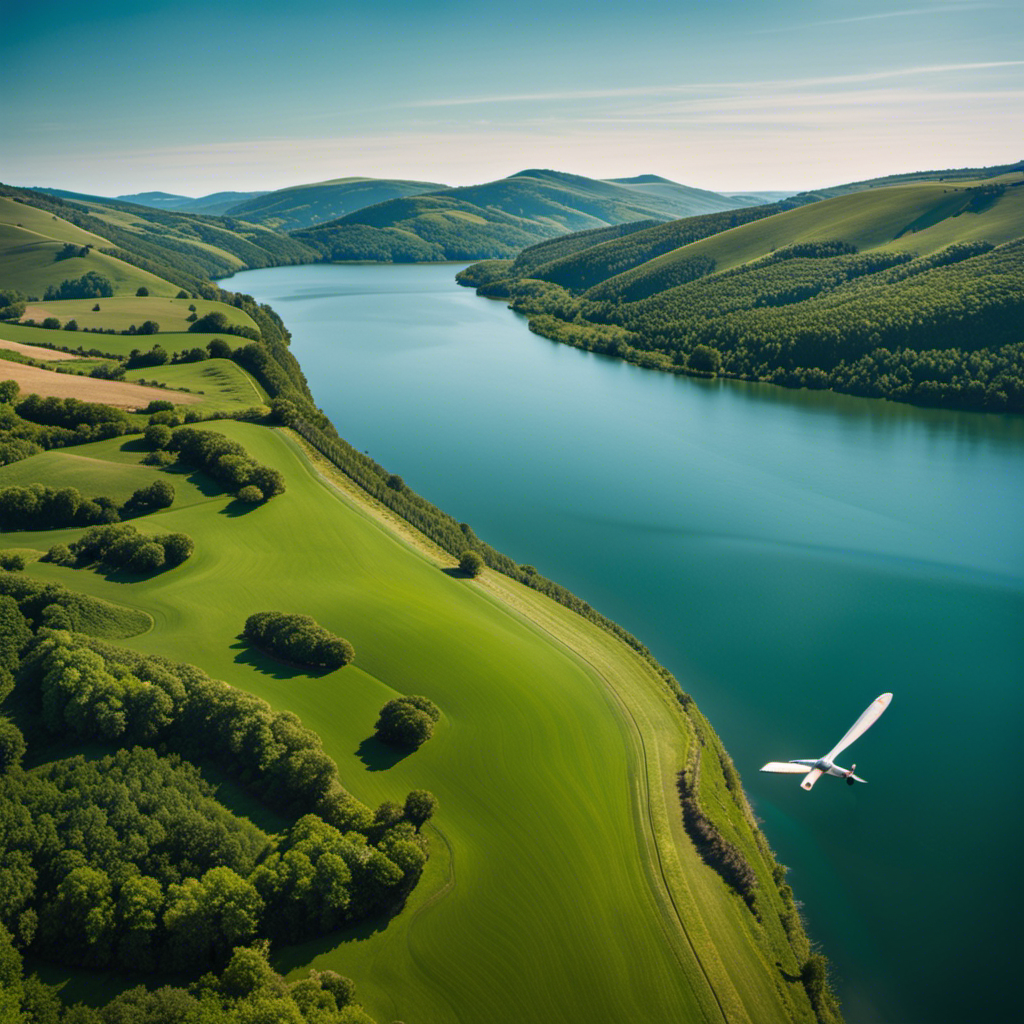As I glide through the sky, I am intrigued by the unseen forces that carry me upwards. **Thermals**, which are strong columns of warm air, play a crucial role in this thrilling adventure. Discover these secrets and feel the excitement of soaring to new heights. Enjoy the journey!
In this article, I will explore the fascinating world of thermals and soaring. We will delve into the science behind thermals, discover techniques for maximizing their potential, and unravel the intricate relationship between thermals and weather patterns.
Join me as we embark on a journey to uncover the art and thrill of thermal soaring.
Key Takeaways
- Mastering the fundamentals of thermal flying
- Importance of proper training in soaring
- Utilizing thermals to gain altitude during flights
- Witnessing wildlife, such as birds, in their natural element
Understanding Thermals and Soaring
Understanding thermals and soaring can be challenging for beginners. However, grasping the basics of thermal dynamics and thermal characteristics is crucial for successful gliding.
Thermals are columns of warm air that rise due to temperature differences between the ground and the atmosphere. As a glider pilot, it is essential to identify the telltale signs of thermals, such as cumulus clouds and rising air currents.
Once in a thermal, the glider can gain altitude by circling within the column of rising warm air. This process allows the pilot to stay airborne and cover long distances.
To delve deeper into the science behind thermals, we need to explore the intricacies of air currents and atmospheric conditions, which dictate the formation and behavior of thermals.
The Science Behind Thermals
Exploring the science behind how warm air currents lift gliders to higher altitudes is fascinating. The physics of thermals plays a crucial role in understanding this phenomenon.
Thermals are columns of rising warm air, created when the sun heats the ground. As the warm air rises, it carries gliders along with it, allowing them to gain altitude without using their engines. This natural lift is also utilized by birds during their migration. By riding thermals, birds can conserve energy and cover long distances more efficiently.
Understanding the science behind thermals is essential for glider pilots and bird watchers alike. It enables them to predict and locate these rising air currents, maximizing their potential for soaring and migration. With this knowledge, pilots and bird enthusiasts can navigate the skies with precision and make the most of these natural wonders.
Techniques for Maximizing Thermal Potential
When it comes to maximizing thermal potential while soaring, two key factors to consider are positioning and timing.
Positioning refers to the skill of finding and staying within thermals, while timing involves knowing when to enter and exit thermals for optimal lift.
Additionally, using instruments and technology can greatly enhance one’s ability to locate and exploit thermals more effectively.
For example, variometers can be used to measure vertical speed, and GPS devices can aid in navigation and tracking.
Understanding these techniques and utilizing the right tools can significantly improve the success of a soaring pilot in maximizing their thermal potential.
Positioning and Timing
To maximize lift, it’s important to know where and when to position yourself in thermals while soaring. Here are some key positioning strategies and timing techniques to help you make the most of your flight:
-
Seek out areas of thermal activity: Look for signs such as cumulus clouds, birds circling, or smoke rising from the ground.
-
Position yourself upwind of the thermal source: This allows you to ride the thermal as it rises, maximizing your altitude gain.
-
Enter the thermal at the right moment: Timing is crucial. Wait for the thermal to fully develop before entering, ensuring a strong and steady lift.
By mastering these positioning and timing techniques, you can efficiently navigate thermals and gain altitude.
Now, let’s explore how instruments and technology can further enhance your soaring experience.
Using Instruments and Technology
You can enhance your flight experience by utilizing instruments and technology that provide valuable information and assistance. Thanks to advancements in instruments and technological innovations, pilots now have access to a wide range of tools that can greatly improve their flying abilities.
For example, GPS navigation systems allow for precise and accurate positioning, ensuring that you stay on the right track and reach your destination safely. Additionally, onboard weather radar systems provide real-time updates on weather conditions, allowing you to avoid turbulent areas and make informed decisions about your flight path.
These advancements in instruments and technology have revolutionized the way we fly, making our flights safer and more efficient. With these tools at our disposal, we can now seamlessly transition into the next section, where we will explore the importance of understanding thermals and weather patterns.
Thermals and Weather Patterns
It’s important to understand how thermals and weather patterns are interconnected in the world of soaring. Weather impacts play a crucial role in the formation and behavior of thermals, which are essential for gliding.
Thermals are columns of rising air that result from the uneven heating of the Earth’s surface. As the sun warms the ground, pockets of hot air rise, creating thermal updrafts. These updrafts are the lifeline of glider pilots, providing the necessary lift to stay aloft and gain altitude.
However, weather patterns greatly influence the strength and availability of thermals. Factors such as wind direction, cloud cover, and temperature inversions can either enhance or inhibit thermal dynamics. Understanding these weather patterns is a skill that every glider pilot must master to navigate and exploit thermals effectively.
Transitioning to the next section, let’s now explore the art of gliding and how pilots use thermals to stay airborne.
Thermals and the Art of Gliding
Understanding the art of gliding involves harnessing the power of rising columns of air, known as thermals, to stay aloft and maneuver through the sky. It is a delicate dance between pilot and nature, where artistic aspects meet mental challenges.
As a glider pilot, I have experienced the sheer beauty of soaring effortlessly through the air, relying solely on the invisible forces of thermals to keep me aloft. The artistry lies in reading the sky, identifying the telltale signs of a thermal, and skillfully maneuvering the glider to enter and climb within it.
The mental challenges come into play as you constantly assess the changing conditions and make split-second decisions to maximize your time in the air. Now, let’s delve into the safety considerations in thermal flying, where careful planning and adherence to protocols are paramount.
Safety Considerations in Thermal Flying
Now, let’s explore the importance of careful planning and adherence to protocols when flying in thermals. Safety precautions and equipment requirements are paramount in ensuring a successful and incident-free flight.
Before taking off, pilots must thoroughly inspect their gliders to ensure they are airworthy and equipped with necessary safety features such as parachutes and emergency locator transmitters. It is also crucial to check weather conditions, paying attention to wind speed and direction, as well as the presence of cumulus clouds indicating thermal activity.
During flight, maintaining a safe distance from other gliders and communicating intentions through radio is essential to avoid collisions. Pilots should also be aware of airspace restrictions and adhere to them to maintain safety.
By following these safety precautions and equipment requirements, pilots can enjoy the exhilarating experience of flying in thermals while minimizing the risks involved.
Transitioning into the subsequent section about ‘advanced soaring techniques,’ it is important to note that once pilots have mastered the fundamentals of thermal flying and have a solid understanding of safety measures, they can begin exploring more advanced techniques to optimize their soaring experience.
Advanced Soaring Techniques
Once pilots have mastered the fundamentals of thermal flying and have a solid understanding of safety measures, they can begin exploring more advanced techniques to optimize their soaring experience.
These advanced techniques involve a deeper understanding of thermal dynamics and how to work with them efficiently. One such technique is called “coreing,” which involves finding the strongest part of a thermal and circling within it to gain maximum altitude.
Another technique is “cloud streets,” where pilots look for long lines of clouds that indicate a strong and consistent thermal lift. By following these cloud streets, pilots can cover long distances and stay airborne for extended periods.
These advanced techniques require a keen eye for reading the sky, understanding wind patterns, and making split-second decisions. With these techniques in their repertoire, pilots can now move on to exploring the role of thermals in cross-country flying, where they can utilize their skills to embark on exciting journeys.
The Role of Thermals in Cross-Country Flying
As I delved deeper into the world of advanced soaring techniques, I couldn’t help but marvel at the role thermals play in cross-country flying. These powerful columns of rising air have a profound impact not only on birds migrating long distances but also on hot air ballooning.
Thermals are formed when the sun heats the ground, causing pockets of warm air to rise rapidly. When glider pilots encounter thermals during their cross-country flights, they can use them to gain altitude and extend their journey. This strategic use of thermals allows pilots to cover great distances and stay aloft for extended periods.
Furthermore, the knowledge of thermal patterns and the ability to exploit them has led to remarkable records and achievements in thermal soaring, a testament to the immense potential of these natural phenomena. In the next section, we will explore the awe-inspiring records and achievements in thermal soaring, showcasing the incredible feats accomplished by skilled pilots harnessing the power of thermals.
Records and Achievements in Thermal Soaring
Skilled pilots have harnessed the power of thermals to accomplish remarkable records and achievements in thermal soaring. In the world of gliding, breaking distance records is a testament to both the pilot’s skill and the power of thermals.
Notable pilots such as Sebastian Kawa and Klaus Ohlmann have achieved awe-inspiring distances by riding thermals for hours on end. Kawa, for instance, set the world record for the longest out-and-return flight in a glider, covering an astonishing distance of 2,809 kilometers. Ohlmann, on the other hand, holds the record for the longest straight-line flight in a glider, having traveled an incredible 3,008 kilometers.
These pilots have pushed the boundaries of what is possible in thermal soaring, inspiring others to explore the thrill of this exhilarating sport.
Exploring the Thrill of Thermal Soaring
After exploring the records and achievements in thermal soaring, it’s time to delve into the thrill of this exhilarating activity. As a soaring enthusiast, I can attest to the unique experience of riding thermals and witnessing the beauty of nature from above. One of the fascinating aspects of thermal soaring is its interaction with wildlife. When riding thermals, pilots often come across birds effortlessly gliding alongside them, taking advantage of the same thermals for their own flight. It’s a remarkable sight to witness the graceful maneuvers of these creatures in their natural element. Moreover, beyond the sheer thrill, thermal soaring also offers remarkable energy efficiency. By utilizing the rising currents of warm air, pilots can extend their flight time and cover long distances with minimal energy consumption. It’s a testament to the incredible design of nature and the ingenuity of human engineering.
To provide a clearer understanding of the dynamics of thermal soaring, let’s examine the relationship between thermals and wildlife, as well as the energy efficiency achieved through this activity. The table below outlines these key aspects:
| Aspect | Description |
|---|---|
| Thermals and Wildlife | Thermal soaring provides a unique opportunity to observe and interact with various bird species that utilize the same thermals for their flight. |
| Thermals and Energy Efficiency | By harnessing the power of thermals, pilots can extend their flight time and cover long distances with minimal energy consumption, making it an environmentally friendly activity. |
Frequently Asked Questions
How long can a thermal last?
Thermals can last anywhere from a few minutes to several hours, depending on various factors such as atmospheric conditions and terrain. Understanding thermal dynamics and employing effective thermal hunting techniques are crucial for maximizing flight time.
Can thermals be dangerous for gliders?
Thermals can be dangerous for gliders due to thermal turbulence. Safety precautions, such as monitoring weather conditions and avoiding strong thermals, are essential. In 2019, a glider pilot encountered severe turbulence in a thermal, resulting in a crash.
Is it possible to predict the strength of a thermal before takeoff?
It is possible to predict the strength of a thermal before takeoff. Factors such as temperature, humidity, wind speed, and terrain can help determine the potential strength of thermals.
How does wind direction affect thermals?
Wind direction plays a crucial role in thermal dynamics. It determines the shape and movement of thermals, influencing how they form and dissipate. Understanding wind patterns and thermals is essential for successful soaring and predicting optimal flying conditions.
Are there any specific signs or visual cues that indicate the presence of a thermal?
When searching for thermals, I keep an eye out for "invisible staircases" in the sky, marked by rising columns of warm air. These thermal detection techniques are crucial for birds’ migration patterns.
Conclusion
In conclusion, thermal soaring is a fascinating and exhilarating sport that combines the art of gliding with the science of thermals. By understanding the principles behind thermals and utilizing advanced techniques, pilots can maximize their flying potential and explore the thrill of cross-country flying.
One interesting statistic is that the world record for the longest thermal flight is 1,026 kilometers, achieved by Steve Fossett in 2006. This highlights the incredible distances that can be covered using thermals, showcasing the remarkable capabilities of both pilots and the power of nature.
With a heart that soars as high as the skies, Aria, affectionately known as “Skylark,” is the driving force behind Soaring Skyways. Her journey into the gliding world began as a young dreamer gazing up at the soaring birds, yearning to experience the weightlessness and freedom they embodied. With years of experience both in the cockpit and behind the scenes, Aria’s commitment to the gliding community is unwavering.










